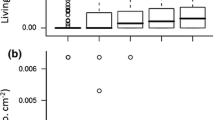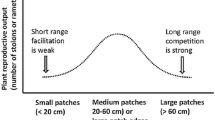Abstract
In a spatially explicit simulation model of vegetation dynamics (‘VegeTate’), I labelled the initial mass of Pteridium aquilinum in each of 225 cells as a single, unique genet or clone. The physical environment was homogeneous and all genets shared the same phenotype. The aim was to discover whether and how the success of each genet was affected by its initial position relative to other genets and a competing grass species. In a scenario in which grazing generated a grass-bracken mosaic with complex spatial dynamics, the amount of growth of each genet ranged widely, from frequent extinction to mass increase by over 300 times. The main factor in the impact of position on genet growth was shown to be a benefit from the initial presence or proximity of a large mass of P. aquilinum. This was because a high density of P. aquilinum reduced local grazing intensity, allowing plant mass to accumulate and shifting the balance of competition in favour of P. aquilinum. Thus variations between cells in initial mass of P. aquilinum were greatly amplified. The implications of this amplification of initial differences between sites for population genetics are briefly discussed. Qualitative features of the spatial distribution of genets at the end of simulations matched reported observations on patchily distributed field populations of P. aquilinum. These features included dominance of a large population by a small minority of genets, widespread mixtures of a dominant genet and one or more subordinate genets, and the presence of patches of P. aquilinum formed both by agglomeration from neighbouring foci and by spread of dominant genets. Under less intense grazing, which allowed little or no development of vegetation mosaics, genet growth varied relatively little and initial variations in relative mass between genets were little changed. Based on this study, I hypothesize that any processes that generate non-linear spatial dynamics will also generate complex genet dynamics.
Similar content being viewed by others
References
Birch, C.P.D. (1999) A new generalized logistic sigmoid growth equation compared with the Richards growth equation. Ann. Bot. 83, 713-723.
Birch, C.P.D. and Hutchings, M.J. (1999) Clonal segmentation: the development of physiological independence within stolons of Glechoma hederacea L. (Lamiaceae). Plant Ecol. 141, 21-31.
Birch, C.P.D., Vuichard, N. and Werkman, B.R. (2000) Modelling the effects of patch size on vegetation dynamics: bracken (Pteridium aquilinum (L.) Kuhn) under grazing. Ann. Bot. 85(Supplement B), 63-76.
Bossart, J.L. and Prowell, D.P. (1998) Genetic estimates of population structure and gene flow: limitations, lessons and new directions. Trends Ecol. Evol. 13, 202-206.
Bullock, J.M., Clear Hill, B. and Silvertown, J. (1994) Tiller dynamics of two grasses -- responses to grazing, density and weather. J. Ecol. 82, 331-340.
Chesson, P. (2000) Mechanisms of maintenance of species diversity. Annu. Rev. Ecol. Syst. 31, 343-366.
Grime, J.P. (1979) Plant Strategies and Vegetation Processes. Wiley, Chichester.
Grime, J.P., Hodgson, J.G. and Hunt, R. (1988) Comparative Plant Ecology. A Functional Approach to Common British Species. Unwin Hyman, London.
Harper, J.L. (1977) Population Biology of Plants. Academic Press, New York.
Hassell, M.P. and Wilson, H.B. (1997) The dynamics of spatially distributed host-parasitoid systems. In: D. Tilman and P. Kareiva (eds), Spatial Ecology: the Role of Space in Population Dynamics and Interspecific Interactions. Princeton University Press, Princeton, pp. 75-110.
Hastings, A. and Harrison, S. (1994) Metapopulation dynamics and genetics. Annu. Rev. Ecol. Syst. 25, 167-188.
Holt, R.D. and Lawton, J.H. (1994) The ecological consequences of shared natural enemies. Annu. Rev. Ecol. Syst. 25, 495-520.
Illius, A.W., Gordon, I.J., Elston, D.A. and Milne, J.A. (1999) Diet selection in goats: a test of intake-rate maximization. Ecology, 80, 1008-1018.
Jeltsch, F., Milton, S.J., Dean, W.R.J. and van Rooyen, N. (1997) Simulated pattern formation around artificial waterholes in the semi-arid Kalahari. J. Veg. Sci. 8, 177-188.
Kimura, M. (1983) The Neutral Theory of Molecular Evolution. Cambridge University Press, Cambridge, UK.
Kudoh, H., Shibaike, H., Takasu, H., Whigham, D.F. and Kawano, S. (1999) Genet structure and determinants of clonal structure in a temperate deciduous woodland herb, Uvularia perfoliata. J. Ecol. 87, 244-257.
Mitton, J.B. (1994) Molecular approaches to population biology. Annu. Rev. Ecol. Syst., 25, 45-69.
Oinonen, E. (1967) Sporal regeneration of bracken Pteridium aquilinum (L.) Kuhn in Finland in the light of the dimensions and age of its clones. Acta Forest. Fenn. 83, 1-96.
Pacala, S.W. and Levin, S.A. (1997) Biologically generated spatial pattern and the coexistence of competing species. In: D. Tilman and P. Kareiva (eds), Spatial Ecology: the Role of Space in Population Dynamics and Interspecific Interactions. Princeton University Press, Princeton, pp. 204-232.
Pakeman, R.J., Le Duc, M.G. and Marrs, R.H. (1997) Moorland vegetation succession after the control of bracken with asulam. Agr. Ecosyst. Environ. 62, 41-52.
Parks, J.C. and Werth, C.R. (1993) A study of spatial features of clones in a population of bracken fern, Pteridium aquilinum (Dennstaedtiaceae). Am. J. Bot. 80, 537-544.
Piqueras, J. and Klimes, L. (1998) Demography and modelling of clonal fragments in the pseudoannual plant Trientalis europaea L. Plant Ecol. 136, 213-227.
Read, J.M., Birch, C.P.D. and Milne, J.A. (2002) HeathMod: a model of the impact of seasonal grazing by sheep on upland heaths dominated by Calluna vulgaris (heather). Biological Conservation, 105, 279-292.
Rodwell, J.S. (1992) British Plant Communities, Grasslands and Montane Communities. Vol. 3. Cambridge University Press, Cambridge.
Rousset, F. and Raymond, M. (1997) Statistical analyses of population genetic data: new tools, old concepts. Trends Ecol. Evol. 12, 313-317.
Scragg, E.B. (1982) The bracken problem and its control in northern Scotland. Proc. Roy. Soc. Edin. B 81, 125-134.
Sheffield, E., Wolf, P.G. and Haufler, C.H. (1989) How big is a bracken plant. Weed Res. 29, 455-460.
Sheffield, E., Wolf, P.G., Rumsey, F.J., Robson, D.J., Ranker, T.A. and Challinor, S.M. (1993) Spatial distribution and reproductive behavior of a triploid bracken (Pteridium aquilinum) clone in Britain. Ann. Bot, 72, 231-237.
Smetham, M.L. (1990) Pasture management. In: R.H.M. Langer (ed.), Pastures their Ecology and Management. Oxford University Press, Auckland, pp. 197-240.
Smith, F.E. (1963) Population dynamics in Daphnia magna and a new model for population growth. Ecology, 44, 651-663.
Sork, V.L., Nason, J., Campbell, D.R. and Fernandez, J.F. (1999) Landscape approaches to historical and contemporary gene flow in plants. Trends Ecol. Evol. 14, 219-224.
Sunnucks, P. (2000) Efficient genetic markers for population biology. Trends Ecol. Evol. 15, 199-203.
Thórhallsdóttir, T.E. (1990) The dynamics of five grasses and white clover in a simulated mosaic sward. J. Ecol. 78, 909-923.
Watt, A.S. (1940) Contributions to the ecology of bracken (Pteridium aquilinum). I. The rhizome. New Phytologist, 39, 401-422.
Watt, A.S. (1954) Contributions to the ecology of bracken (Pteridium aquilinum). VI. Frost and the advance and retreat of bracken. New Phytol. 53, 117-130.
Wiegand, T., Milton, S.J. and Wissel, C. (1995) A simulation model for a shrub ecosystem in the semiarid karoo, South Africa. Ecology, 76, 2205-2221.
Wiegert, R.G. (1974) Competition: a theory based on realistic, general equations of population growth. Science, 185, 539-542.
Williams, G.H. and Foley, A. (1976) Seasonal variations in the carbohydrate content of bracken. Bot. J. Linn. Soc. 73, 87-93.
Winkler, E., Fischer, M. and Schmid, B. (1999) Modelling the competitiveness of clonal plants by complementary analytical and simulation approaches. Oikos, 85, 217-233.
Author information
Authors and Affiliations
Rights and permissions
About this article
Cite this article
Birch, C.P. The influence of position on genet growth: a simulation of a population of bracken (Pteridium aquilinum (L.) Kuhn) genets under grazing. Evolutionary Ecology 15, 463–483 (2001). https://doi.org/10.1023/A:1016001418743
Issue Date:
DOI: https://doi.org/10.1023/A:1016001418743




